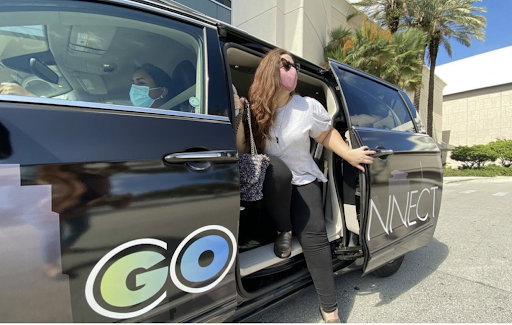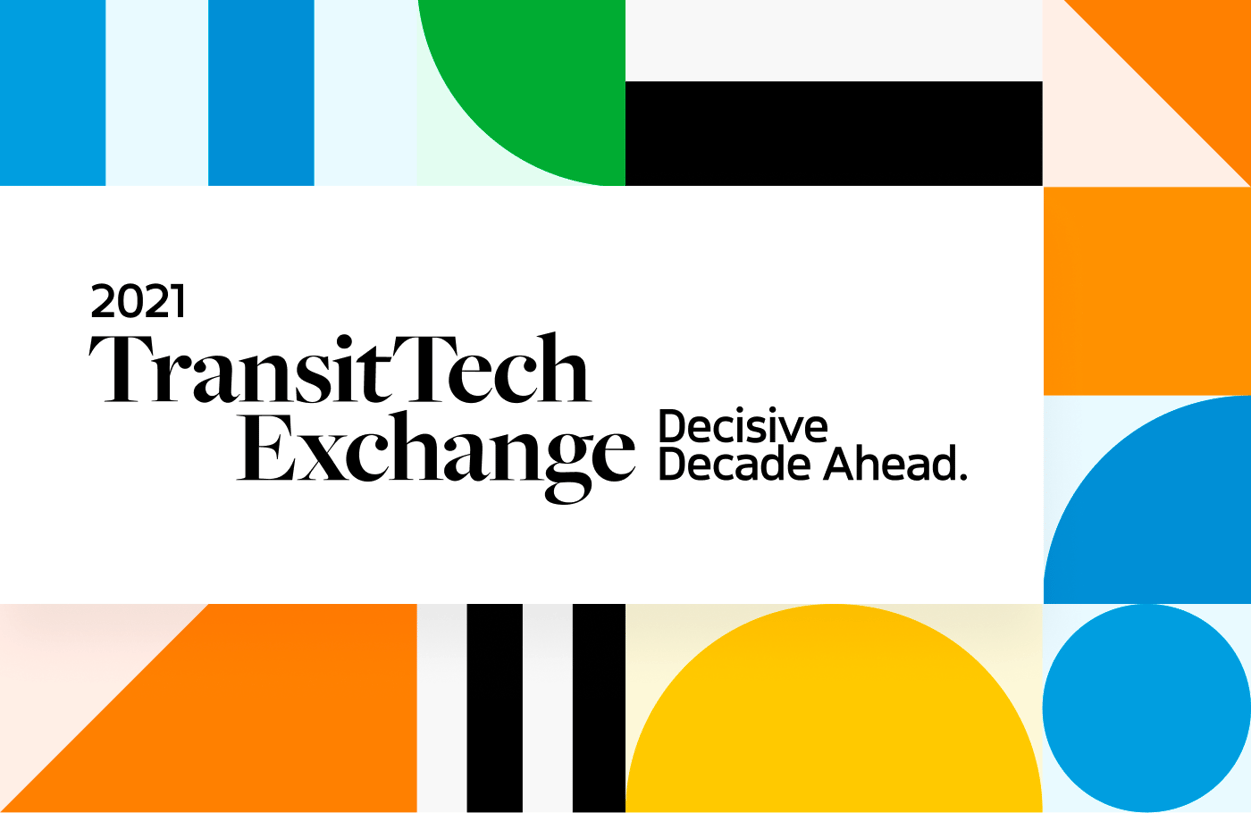Last month, we convened some of the most prominent transit movers and shakers at our first-ever TransitTech Exchange. Over the course of two days, industry leaders shared critical insights, brainstormed in breakout rooms, and presented on best practices across the industry. Here are some of the biggest takeaways as we plan for the next decade.
1. Evaluate access — or “the wall around your life.”
Keynote speaker Jarrett Walker, founder of transit consultancy Jarrett Walker + Associates and author of Human Transit, uses the phrase “a wall around your life” to refer to the limit of where you can travel with the amount of time in your day. He believes this may be the most important metric when we evaluate transport systems — but we usually don’t consider it.
We should prioritize access, he argues — that is, the freedom good transit offers riders — for effective network design. “In fact, access is the foundation of how network design affects ridership or patronage,” he says. Increasing access brings more riders to public transit, which also helps reduce congestion and emissions in your city. The accessibility of a transit network can also be used as an indicator of a city’s economic function through metrics like commute time, which suggests how well a city is connecting laborers with opportunities. “When we expand access, we expand freedom,” says Walker. By pushing the limits of the areas where we couldn’t get, we are bridging the gap between people and opportunities. “This is the thing equity and social inclusion should be about,” he adds.
2. On-demand may be key to post-COVID recovery.
Simon Reed, Head of Technology and Data, Surface Transport at Transport for London, points out that the speed of adaptability and the amount of change that transit providers have had to deal with in the last 12 months is phenomenal. “Everybody knows that cash may be gone from our transport network completely someday, but 10 years’ worth of changes have happened in the past 12 to 15 months,’’ he says. “Changes are going to come much faster.” Reed and Scheherazade Zekri, Director of New Mobility Services at Keolis Group, have both seen 60-70% ridership recovery on their public transport network, with the recovery scale varying in different sectors.
Zekri emphasizes that, in the mass transit sector, on-demand services have bounced back much faster than other modes. Road transport levels, for instance, are about 90% of what they were in pre-COVID, with cycling surpassing pre-COVID levels, while public transport use (while increasing) is lagging behind, says Reed.
“On-demand transit is very close to about 95% recovery of where we were before COVID-19,” notes Zekri. “People tend to feel safer being in smaller vehicles where distancing was respected at first , and they also think smaller cars are cleaner.”
“I think people are still scared to go outside and another big thing for us is that a large portion of us are working from home. Our goal as a bus company is to hit ‘the second car’ and really think about how to move people to a car-light lifestyle in a creative way,” says Austin Blackburn, Managing Director at Go-Coach in Sevenoaks.

3. The UK’s National Bus Strategy is a critical step forward.
In March 2021, the UK Government announced its first National Bus Strategy, also known as ‘Enhanced Partnerships,’ with the aim to make buses “more frequent, more reliable, easier to understand and use, better coordinated and cheaper.” It requires bus operators to commit to working with local councils to assess the state of the network, moving service towards goals like ten-minute frequencies.
Adele Wearing, Strategic Lead for Passenger Transport at Milton Keynes, says her team and the local operators have welcomed the strategy. “It's a great opportunity to pull together and deliver many things that we've wanted to achieve for a long time. We're in the midst of those discussions with our operators and trying to think ambitiously and look at how we can really change for the better on a massive scale. We're not tinkering around the edges anymore — having that really clear direction is fantastic for us.”
4. Ridership isn’t always the best KPI.
Carlos Cruz-Casas, the Assistant Director of Transportation & Public Works at Miami Dade County in Florida, argues that adopting an on-demand approach to transportation could help communities easily access more mobility choices. He urges against using ridership as the sole indicator of a transit system’s performance. “To me it was very evident in 2020, ridership is not the right metric for us to capture on transit benefits,” he said. Instead, Cruz-Casas suggests looking at what the transportation and mobility needs of the community really are, not just getting people into the fixed route, and considering customer experience in order to make sure the transit is a viable mobility solution for them. Riders are more inclined to use transit services across the entire network as they become less dependent on their personal cars. This modal shift is an overall, long-term benefit that transit authorities can capture.
“If you think about the entire transportation spectrum, on-demand service is really beneficial as a mobility ecosystem component,” said Cruz-Casas.

5. The next decade will see a rare opportunity to change cities for the better.
Since the onset of COVID-19, we’ve seen cities transform streets into testing sites and restaurants, while transit agencies repurposed existing assets to support vaccine rollout through mobile vaccination clinics and shuttles to vaccination sites.
Keynote speaker Paul Supawanich, Associate Director of Programs at the National Association of City Transportation Officials, noted how the pandemic has enabled us to realize streets are meant to do more than just move cars. Rather, our existing infrastructure can be used to advance many social goals of our local communities — and now is the time to ask tough questions about where we go next. “This is really the moment where we have all of the information we need to be decisive about the decade ahead,” says Supawanich. “We've never been in a better position to help define the trajectory of what the next 10 years could be.”
Other panelists shared Supawanich’s optimism over what the next decade could bring. Monica Tibbits-Nutt, Board member of MassDOT & MBTA, says cities should go beyond just taking back our streets and eliminating parking. “Looking at the areas where we have corridors, whether it’s a rail corridor or anything like that, and taking out the rails, [incorporating] battery electric buses and bus rapid transit” could mean enhanced flexibility. “We've never really been in a better position to help define the trajectory of what the next 10 years could be.” — Paul Supawanich There’s also been a flattening of our typical rush hour peaks in the morning and the evening — a good reminder of how often we’ve dedicated our resources to those peaks, thus catering transit primarily to nine-to-five, white-collar workers. This moment gives us an opportunity to rethink service design to better meet the needs of underserved communities, like overnight shift workers, seniors, and people with disabilities.
Veronica Vanterpool, Chief Innovation Officer at Delaware Transit Corporation, imagines the next decade could bring about a big perception shift — one that could be truly transformational. “I wish we could change the perception that people who walk, bike, and take transit are inferior. If we make this perception shift, we could move a bus network forward, and by building a true BRT (Bus Rapid Transit), we could really transform our land use patterns, and fix environmental or inequity problems in our communities.”
6. Better connections = better partnerships.
In an effort to explore new mobility options, many cities and transit agencies have partnered or are seeking new partnerships with other organizations like service providers, operators, administration, etc. To foster better cooperation with all of them, Caroline Rodriguez, Regional Transportation Planning Director at Summit County in Utah, thinks the key is to ensure everyone acknowledges the impact of the transportation projects. “We always consider the impact [of the projects] on trails organizations and how these successes could match what they are trying to achieve to generate funding or support for their projects,” she says. “We should take the conversation one step further to determine how each department or agency's individual project can benefit or impact another agency's projects.”
While addressing impact is crucial, Cruz-Casas emphasizes the importance of figuring out a “common narrative” between all the sectors. “I recommend using a very simple tool to basically show anyone out there: This is what I mean when I talk about protected bike lanes or crosswalks. A common narrative and common language are critical for that partnership conversation to happen.”
If you’re ready to take action, learn more about the joint ventures of Via and Remix here .




